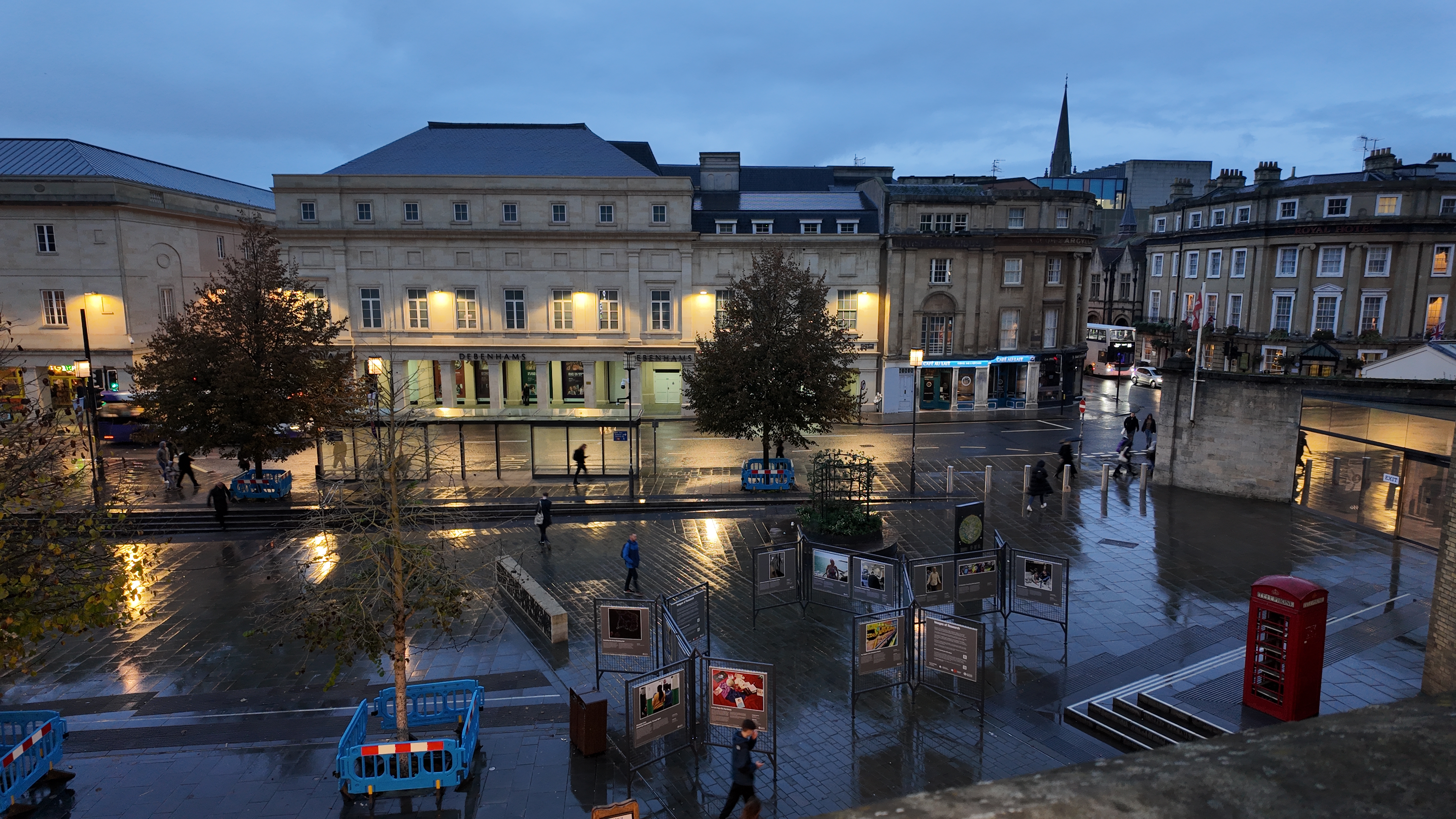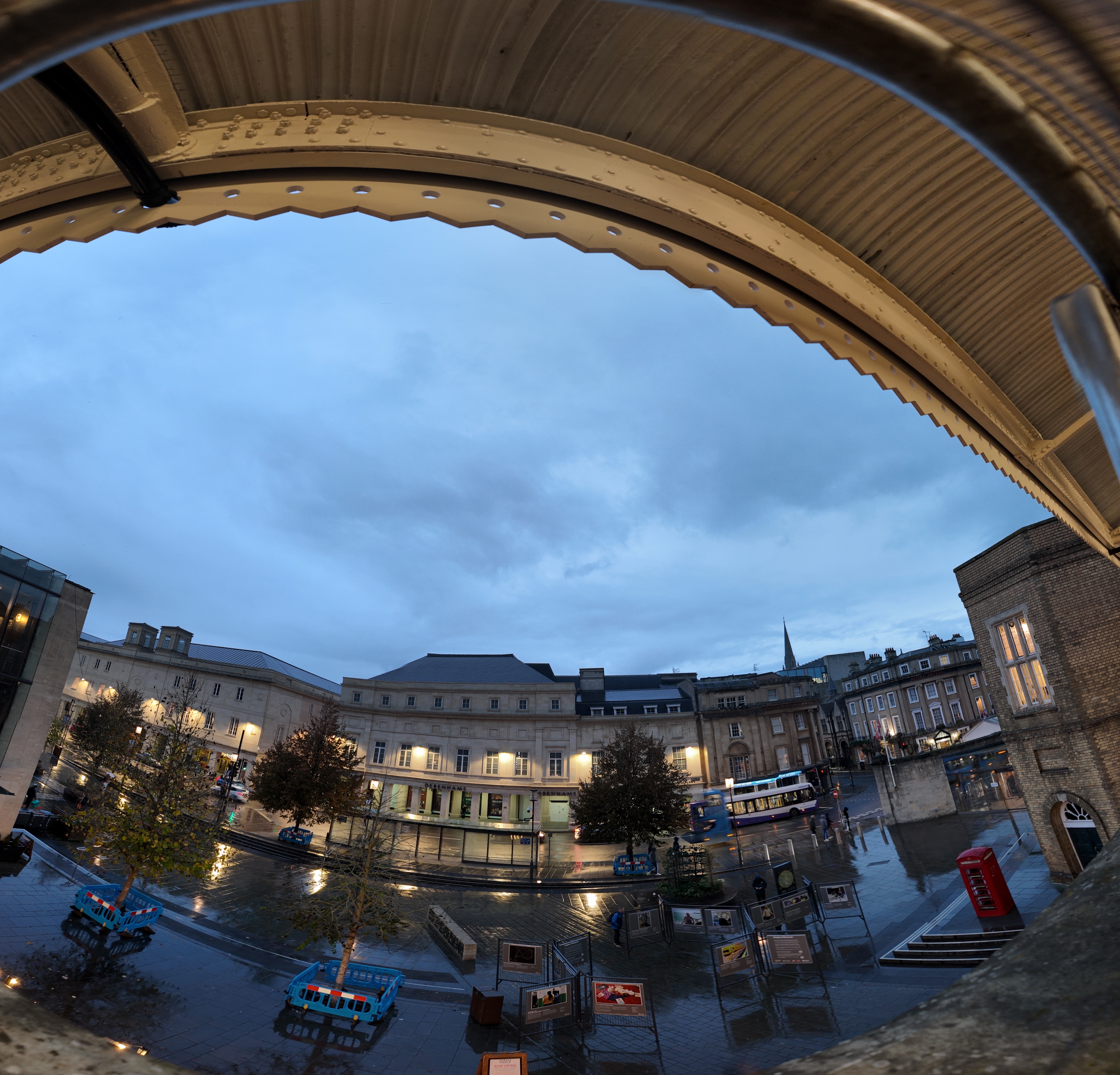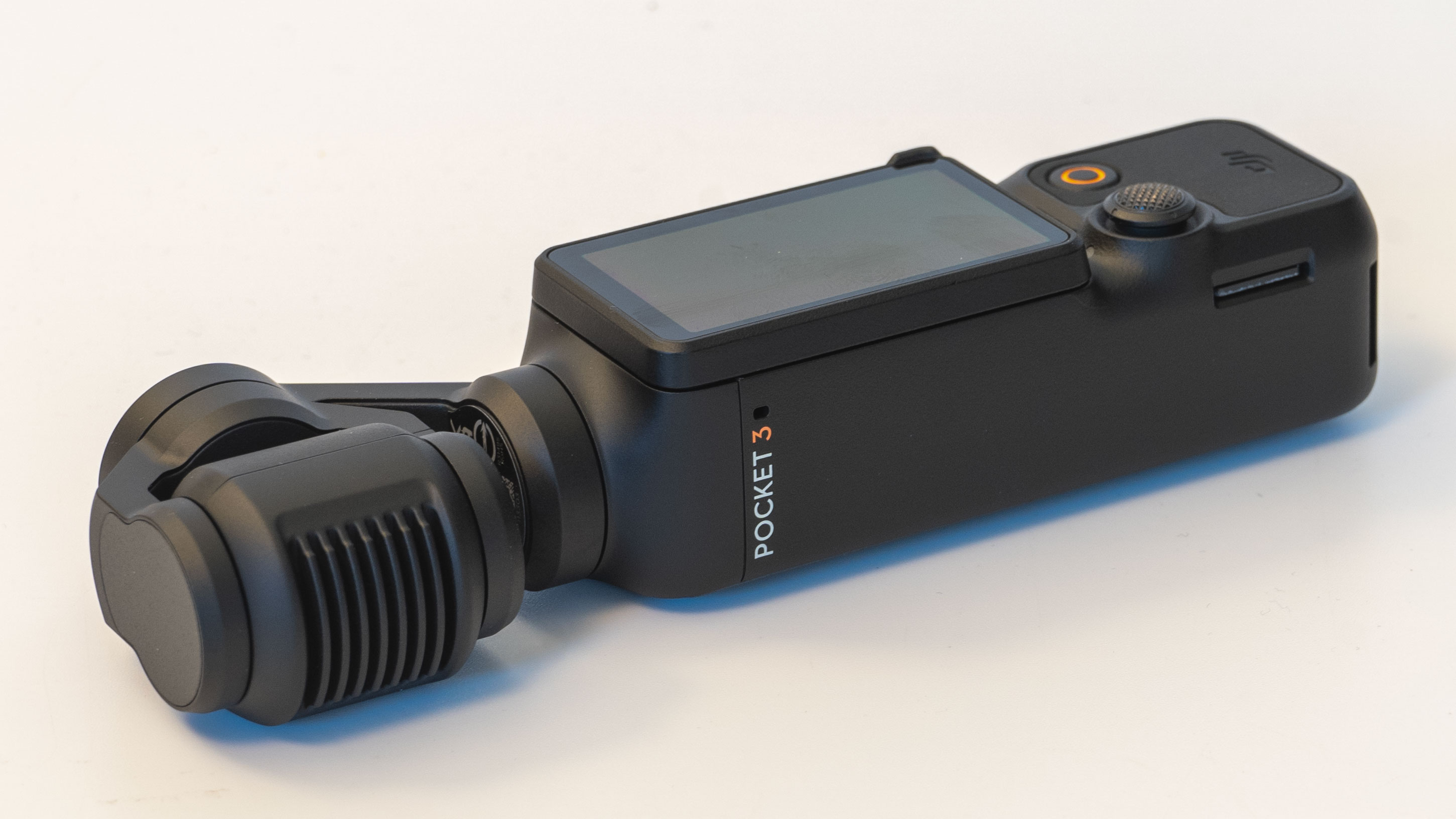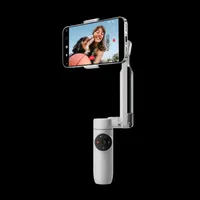Digital Camera World Verdict
An excellent camera which still defies categorization but somehow manages to be ideal for both vloggers and tourists while also having the grit to serve as a tiny portable TV studio. The bigger sensor and screen make for a huge improvement over the Pocket 2, though the price hike means this is far from a casual purchase.
Pros
- +
Bigger display massively improves use
- +
Creator combo offers high-quality vlogging
- +
Video is crisp across light
- +
No handle required for wireless mic
- +
10-Bit video and 32-bit sound options
Cons
- -
Big price jump over Pocket 2
- -
Auto exposure tends to brighten
- -
Takes a while to uncover all the features
- -
More vulnerable than an action camera
Why you can trust Digital Camera World
The DJI Osmo Pocket 3 is, as the name implies, the third in a line of a small camera, though it doesn't look a lot like you might imagine a pocket camera to. Nor, to be honest, do we think it'd fare well in a lot of trouser pockets. Instead, it takes the form of a handle-supported gimbal, a bit like a grounded version of one of DJI's drones. (We'd say – if you're devoted to the 'Pocket' name, it'd be safer to keep it in a jacket's inside pocket, like James Bond does with his pistol.)
Image sensor: 1-inch
Lens: 20mm EFL / ƒ/2.0
(wide angle adapter available)
Focal range: 0.2m – ∞
Video resolution: 4K / 60fps (120fps)
ISO: 50-16,000
Still resolution: 3840 x 2160 / 3072 x 3072
Bit rate: 130 Mbps
Display: 2-inch (314x556px)
Size: 139x42x34mm
Weight: 179g / 0.39 pound
Not long ago DJI one-upped GoPro by putting a bigger, better sensor in their GoPro-shaped Osmo Action 4. The Pocket 3 seems to bring the same sensor – and with it the same low-light abilities – to the device we've never quite been able to categorize: the Pocket series. This is the third generation of what is essentially a drone's gimbal camera you can hold in your hand – it isn't an obvious category but vloggers, tourists, and perhaps now serious pros might all find uses for the 4K 120FPS camera with 10-bit recording and HDR.
The gimbal makes it physically less rugged than a typical action camera, of course, but brings the ability to track a subject, and introduces automated panning effects. DJI's ActiveTrack 6.0 is included, a technology which has the advantage of being refined over many generations of drones with gimbal cameras. Indeed the device shares a lot in common with its flying as well as its grounded siblings from DJI. It can, of course, also be operated via an app which will handle livestreaming too.
In fact, creators and streamers for vertical format (TikTok, Instagram, YouTube Shorts) have clearly been on DJI's mind with the Pocket 3 which has a rotatable 2-inch monitor (that also acts as a power switch), while the device can connect directly to one of DJI's new DJI Mic 2 Bluetooth microphones for good quality sound as you live broadcast on the go.
DJI Osmo Pocket 3: Build & Handling
DJI lent me the full Osmo Pocket 3 Creator Combo, which includes a mini tripod, battery handle, case, and the DJI Mic 2 atop the camera and standard goodies, so I'll look at the whole bundle but bear in mind that if you don't need the microphone or other accessories there is a— well, not cheap, but less expensive route to ownership.
On looking at the Pocket 3's predecessors, it's been tempting to dismiss it as a gimmicky or novelty device, but DJI has gone some way to address this in the form, even before we get to function. The device is designed to be flexible, not just with the signature rotating display, but with a variety of handle lengths and weights.
The best camera deals, reviews, product advice, and unmissable photography news, direct to your inbox!
The camera itself looks a little insubstantial (what we call 1-inch, remember, is a curious standard from the history of broadcasting, which is actually about 15.9mm across – also true, of course, for traditional vlogging cameras with "1-inch" sensors from Sony and the like). On the plus side, it's lost the slightly tacky red rim of the Action 2's lens, and the gimbal is definitely a bit more rugged than that found on DJI's lightweight drones.
The handle has gained a professional-feeling dark grey panel with a diagonal texture to serve as a grip. The two-tone approach also looks very classy, and is repeated on the various grips for a consistent look.
When closed the display sits very flush with the body, with a slight lip in the lower right to make rotating it (which also serves as the power switch) easy, even with gloves. Beneath the display are the joystick and record buttons in their own small panel – their surround is rubberized while the rest of the device is high-quality plastic.
On the base of the device is a USB-C socket which plugs into the various adapters that extend the length of the handle. You can use it without, though you'll want dainty hands. In the standard kit you get a light "grip," – basically a 1-inch cube – and at the base of this is a tripod thread. It also has a USB-C socket on the front so it doesn't block the USB connection if needed. (It can also be used as a webcam via this connection, at up to 4K 30fps or 1080p 60fps.)
The 950mAh Battery Handle is a little longer (and, of course, somewhat heavier), but does offer more than the standard 166 minutes. The device and battery grip can both take a fast charge, so get up to 80% in a matter of minutes. Both adapters connect with claw-like locks at the sides and come off with a press of a central button.
The flexibility is not limited to the base. Despite being on a gimbal the lens has magnets so the camera can accept ND filters or a wide-angle lens adapter. There is also the option, like the Pocket 2, of an Expansion Adapter for wearing the device.
In summary, we're looking at a consistently-designed and very flexible system. Control comes through the joystick/button and record button or via the phone app which is also reasonably logical – swipe in from the sides of the display to bring up various menus. The camera will insist on being paired with the Mimo app early in its life, but that is a handy tool (and essential for streaming).
DJI Osmo Pocket 3: Performance
If you've used the Pocket 2, you'll know that the compact display was an issue; the new rotating 2-inch screen solves this for all but the biggest of fingers, though I honestly found one of the signature features genuinely difficult to get my head around – the rotating screen/switch.
Rotate the display to horizontal, and on comes the camera. Rotate it back to vertical and – within 2 seconds – it powers down, unless that is, you can get your finger to the 'Continue' button in time. Actually switching to vertical shooting is done (by default) through the menu which you swipe down from the top of the display which doesn't seem obvious, especially for vertical shooters. Though you can make it automatic, you'll still need to dissuade the camera from switching off (all of which is a long-winded way of saying that switching the camera on for the 3K vertical shooting mode is 'click, click, tap' not 'click').
Still, it only takes a few moments to get shooting, and given the range of functions to explore the organization is logical – swipe pages in from the side of the display. It'll certainly be familiar to those used to DJI's touchscreen Osmo Action camera series. It is also an interface which smacks of experience; features like 'start on switch on' are available as options, and you can choose the preferred gimbal startup direction (selfie or away). The device, in other words, can be tailored to your needs and the software understands that people have a variety of uses for this flexible device.
The Mic 2 is excellent too, and we saw 32-bit float was an option in the settings (the mic has 8GB storage on board). It records audio as a track into the video and as separate audio files on the mic for editing, and it is genuinely difficult to get it to clip in 32-bit mode.
DJI Osmo Pocket 3: Camera Performance
I tried the device in light and dark, indoors and out, though I have to be fair, I was testing in the UK so not in much sun! That would have been a challenge for the older model (or pretty much any action camera), but the 1-inch sensor makes light work.
The subject tracking is quick to select a subject and holds onto it well; the all-pixel focussing is very quick and in the sample video, you'll see a clip of my son trying to trick the camera tracking on a cloudy day. It nevertheless follows him quickly with only the briefest of lags. (The focus does have trouble once he gets closer to it than the 20cm focal range.)
It's difficult to express how much better the ActuveTrack 6.0 is than ActiveTrack 3.0 (in the DJI Pocket 2), but the easiest way to put it is that the older model looked, well, a bit robotic whereas for the most part this is smooth and natural. It's not perfect, especially with obstacles, but it is surprisingly reliable.
The presence of the gimbal means that, in comparison to other easily transportable cameras like the best action cameras, it is easier to choose a shutter speed as low as 30/25fps without obvious issues in motion footage. This is the massive advantage of the gimbal.
You'll need the Mimo app to make the most of the TikTok-friendly Glamour Mode (skin cleansing, lip enhancement, and the like) since a phone screen gives more room to describe the feature and tweak the settings, but you can still turn it on and off on-device and achieve a lot with the built-in menus, unlike some compact cameras.
The option to record in 10-bit D-Log gives possibilities in grading for serious creatives, and DJI make a LUT (Look-up Table) available for download – a very accurate one too (not that there is much wrong with DJI's 8-bit files). 4K slow motion can also now be shot in 10-bit (up to 120fps) following a post-launch firmware update.
DJI Osmo Pocket 3: Video Samples
The video includes samples shot on a cloudy day and the evening (sorry, no bright sun). The crispness of my untidy hair and sharp focus are impressive. The camera tracking's ability to follow the small train is also notable (as well as the enthusiastic child)!
DJI Osmo Pocket 3: Stills Samples
The stills are unlikely to be of much interest to Pocket 3 buyers, though the camera does have a Jpeg+RAW shooting mode. There is also the Panorama feature – which automatically rotates the camera and stitches multiple shots. This is lifted straight from the drones, and is brilliant, if rather somewhat 'fish-eye' like.




The standard Jpegs, when caught in the light and dark of the station, showed a lot of digital sharpening, though perhaps no more than most phone owners are used to. Tones were good, and the range is impressive, with detail in the shadow areas and only areas very near lights completely blown.
DJI OSMO Pocket 3: Overall verdict
On purely technical grounds, the Pocket 3 is fabulous, providing the perfect device for all kinds of shooting scenarios. For YouTubers at 4K or 'grammers & TikTokers at 3K this is great, and the bigger display & sensor make a huge difference over the previous generation. It's hard to understate how good gimbal-stabilized video looks without much practice, and that is helped even more by the simple but generally reliable tracking tools.
Would we actually put it in our pocket? Yes, but not a vulnerable one. Definitely not in my phone or wallet pocket, or near my keys – better to use the case! But crucial question: Is it something you'd put your hand into your pocket for? For all sorts of reasons "Yes," with the proviso that your pockets are deep enough.
This is a pricey device and, unless the content you are creating will benefit from the features, there are cheaper routes. Even its predecessor isn't a bad shout in good lighting (and it can also do the Mic thing with the right accessory). If money is an object, it is worth bearing in mind that action cameras and even some phones have digital image stabilization, and gimbals can be acquired for both as accessories.
Where this shines is by being both complex and simple at once – like a system camera. It is the center of a vlogging universe and you can buy most of that universe in the Creator bundle. Video on the move, or video where the subject moves, will stand out (and we'd recommend the Creator Combo for most users to be honest – especially as it's still the only way to get the brilliant 32-bit float DJI Mic 2 at the moment).
Thought of that way, too, you realise that it isn't actually that expensive. What initially seems expensive is actually a good price compared to a high-end vlogging camera like a Sony ZV-1F – which might look more traditional but don't have a gimbal, and require mics to be attached rather more inelegantly.
✅ Buy this if...
- You want to create slick vlogs and live streams
- You're looking for a portable studio with a wireless microphone
- You need HDR and 10-Bit video to edit with
🚫 Don't buy this if...
- You need a rugged action camera
- You're looking for a cheap option
- You don't want to sync with a phone for some controls
You might also like...
The most obvious alternative – if you're looking to save a bit of cash – is the predecessor; the DJI Osmo Pocket 2. This, too, has a gimbal and 4K shooting though lacks the low-light quality of the newer model.
The Insta360 Flow is a gimbal mount for your phone with an extendable arm, 3-axis stabilization, and AI-based subject tracking called 'Deep Track 3.0' so (if you've got a good phone camera) this could be a low-cost alternative.
While the Pocket series has a unique portable quality, we also have guides to the best gimbals for phones and the best gimbals for mirrorless & DSLR cameras.

With over 20 years of expertise as a tech journalist, Adam brings a wealth of knowledge across a vast number of product categories, including timelapse cameras, home security cameras, NVR cameras, photography books, webcams, 3D printers and 3D scanners, borescopes, radar detectors… and, above all, drones.
Adam is our resident expert on all aspects of camera drones and drone photography, from buying guides on the best choices for aerial photographers of all ability levels to the latest rules and regulations on piloting drones.
He is the author of a number of books including The Complete Guide to Drones, The Smart Smart Home Handbook, 101 Tips for DSLR Video and The Drone Pilot's Handbook.











